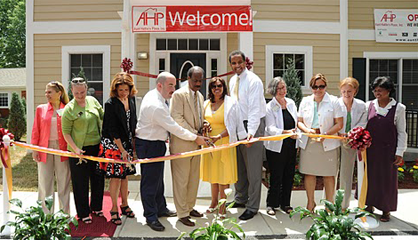State board denies contract to group home built with state funds
By Christopher Goins
 The Maryland Board of Public Works on Wednesday denied a contract to a group home that the state and Montgomery County have previously invested in, virtually ensuring the foreclosure of the Sandy Spring group home, its founder said.
The Maryland Board of Public Works on Wednesday denied a contract to a group home that the state and Montgomery County have previously invested in, virtually ensuring the foreclosure of the Sandy Spring group home, its founder said.
Aunt Hattie’s Place Inc., started in 1997 to prepare at-risk male youth to reunite with their families or become independent, has received contracts every year since its inception, founder Hattie Washington said.
The state gave $1.4 million of taxpayer money towards the construction of its Sandy Spring facility and Washington borrowed $1.4 million from the bank and used her house as collateral, she says. Construction lasted six years and the home opened up in 2010.
The board denied a three-year contract renewal to the group for $2.7 million, with Gov. Martin O’Malley and State Treasurer Nancy Kopp siding with the decision by the Department of Human Resources. Comptroller Peter Franchot was absent.
Hattie’s Place also operates homes in Randallstown and Baltimore City and houses 24 male youth altogether.
Founder says she might lose her home
UPDATE: If the money goes, Washington says she might lose her home, since she put her house up as collateral to build the group home. Department spokesman Brian Schleter said, “All children will be moved by the end of the month to a new home.”
Human Resources Secretary Ted Dallas told the board that he accepted the recommendations his board gave him to deny a contract renewal for the Sandy Spring group home.
“I didn’t see anything that could actually overturn that recommendation,” Dallas said.
He said the decision was based on an examination of financial proposals, technical proposals, and performance scores. He said that Aunt Hattie’s Place came in last on the technical side, and was outperformed by other vendors.
Hattie’s protests evaluation
The methodology used to evaluate Aunt Hattie’s House was disputed by Washington, and her daughter, Cheryl Washington, former executive director of the home. The younger Washington said Hattie’s Place should be re-evaluated.
Dallas cited a “child maltreatment” incident – a fight between residents whose occurrence wasn’t discovered until the next day – as one of the reasons why the group lost points on its proposal.
But Hattie Washington said that was the only incident that occurred in 16 years. As for performance, she pointed to the fact that her company was ranked first in two regions and second in Montgomery County the last time she had to submit a proposal in 2009. She also pointed to two Minority Business Enterprise (MBE) awards she received in 2009 and 2012.
“How did we go from number one to the last place? We have the same program,” said Cheryl Washington.
The move to deny Hattie’s Place funds has caught the attention of Sen. Karen Montgomery, Montgomery County Executive Isiah Leggett, County Council President Nancy Navarro, and Council member George Leventhal.
“The motive and rationale for “Place Matters” must be placing children in the ‘best’ place for the children, not saving money on the backs of those most in need,” wrote Montgomery in a June 5 letter to Ted Dallas.
Leventhal and Navarro complained that part of Montgomery County’s half of the agreement to fund the home was to make sure it would be in operation until at least July 2020.
The Place Matters program was created to place Maryland foster children with permanent families.
Silver Oak Academy expansion approved
The Board also gave the green light for the expansion of Carroll County’s Silver Oak Academy population, enabling the facility to take in 96 youth instead of 48. Rites of Passage, which owns and runs the facility, received about $9.3 million for the expansion.
The facility opened up in July 2009 with just nine boys.
Because it’s not subject to the state’s 48-bed cap like other facilities, Silver Oak Academy can take in more juveniles.

MarylandReporter.com is a daily news website produced by journalists committed to making state government as open, transparent, accountable and responsive as possible – in deed, not just in promise. We believe the people who pay for this government are entitled to have their money spent in an efficient and effective way, and that they are entitled to keep as much of their hard-earned dollars as they possibly can.

